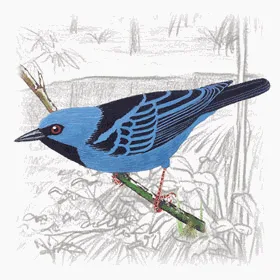 Blue Dacnis [order] Passeriformes | [family] Thraupidae | [latin] Dacnis cayana | [UK] Blue Dacnis | [FR] Dacnis bleu | [DE] Blaukopfpitpit | [ES] Mielero Azul | [IT] Dacne azzurra | [NL] Blauwe Pitpit Subspecies
Physical charateristicsThe Blue Dacnis is 12.7 cm long and weighs 13 g. It has a relatively short bill compared to other honeycreepers. The adult male is turquoise blue with a black forehead, throat and back. The wings and tail are black, edged with turquoise. The female and immature are mainly green with a blue head, paler green underparts and green-edged brown wings. Listen to the sound of Blue Dacnis [audio:http://www.aviflevoland.nl/sounddb/B/Blue Dacnis.mp3]
RangeIt is found from Nicaragua to Panama, on Trinidad, and in South America south to Bolivia and northern Argentina. HabitatIt is common in the sunlit forest canopy, at forest edges, and in second growth forests ReproductionThe bulky cup nest is built in a tree and the normal clutch is brown-blotched white two eggs. The female incubates the eggs and is fed by the male. Feeding habitsIt is usually found in pairs or as part of a mixed species flock high in the canopy. They feed on fruit and insects which they find on leaves. These are social birds which eat mainly insects gleaned from foliage, flowers or bromeliads. Fruit is often taken and usually swallowed whole, but nectar is rarely consumed. ConservationThis species has a large range, with an estimated global Extent of Occurrence of 12,000,000 km². The global population size has not been quantified, but it is believed to be large as the species is described as ‘frequent’ in at least parts of its range (Stotz et al. 1996). Global population trends have not been quantified, but the species is not believed to approach the thresholds for the population decline criterion of the IUCN Red List (i.e. declining more than 30% in ten years or three generations). For these reasons, the species is evaluated as Least Concern.  MigrationSedentary throughout range Distribution map LiteratureTitle Ecological relationships between feather mites (Acari) and wild birds of Emberizidae (Aves) in a fragment of Atlantic Forest in northeastern Brazil Author(s): Rachel M. de Lyra-Neves Angela M. Isidro de Farias & Wallace R. Telino-Junior Abstract: The objective of this study was to investigate fea..[more].. Source: Revista Brasileira de Zoologia 20 (3): 481-485, 2003 |
]]>
